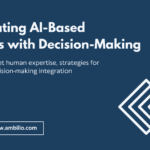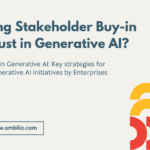As generative AI technologies, including large language models (LLMs) and image generation tools, advance, enterprises are increasingly integrating these solutions into their operations. However, accurately quantifying the cost and return on investment (ROI) of generative AI implementations remains a complex challenge. This article explores the key factors involved in assessing the financial impact of generative AI solutions for enterprises, covering infrastructure and computing resources, data acquisition and preparation, model development and fine-tuning, integration and deployment, licensing and subscriptions, and human resources, to provide a comprehensive understanding of their financial implications.
Understanding the Costs
Understanding the various cost factors involved in deploying generative AI solutions helps enterprises allocate resources efficiently and plan for sustainable investments.
1. Infrastructure and Computing Resources
One of the primary costs associated with generative AI solutions is the computational infrastructure required to run these models. This includes:
- Hardware: High-performance GPUs or specialized AI accelerators are essential for running complex AI models efficiently. These hardware components can be expensive, especially when scaling up for large enterprises.
- Cloud Computing: Many enterprises opt for cloud-based AI services to leverage scalability and reduce the need for physical infrastructure. However, the cost of using these cloud services can add up quickly, particularly with high usage.
- Energy Consumption: Running AI models, especially large-scale deployments, consumes significant power. Enterprises must consider the energy costs associated with continuous model training and inference.
Enterprises must consider both upfront capital expenditures and ongoing operational expenses related to infrastructure.
2. Data Acquisition and Preparation
High-quality training data is crucial for effective generative AI models. Costs in this category include:
- Data Collection: Gathering relevant data from various sources can be a time-consuming and expensive process. This involves acquiring data from internal databases, third-party providers, or public sources.
- Data Cleaning and Preprocessing: Ensuring data quality and compatibility is essential for accurate model training. This process involves cleaning, normalizing, and formatting data, which can be resource-intensive.
- Data Labeling: Manual or semi-automated labeling of training data is often necessary to provide the context required by AI models. This can be a labor-intensive process requiring significant human effort.
- Data Storage: Maintaining secure and scalable data storage solutions is crucial. As data volumes grow, storage costs can increase substantially.
3. Model Development and Fine-tuning
Developing or customizing generative AI models for specific enterprise use cases involves:
- Research and Development: Exploring suitable model architectures and techniques requires investment in R&D. This phase includes experimentation with different algorithms and approaches.
- Training Costs: The compute resources and time required for model training are significant. Training large models can take days or even weeks on powerful hardware.
- Fine-tuning: Adapting pre-trained models to specific domains or tasks is essential for optimal performance. Fine-tuning requires additional computational resources and expertise.
- Ongoing Optimization: Continuous improvement of model performance through regular updates and refinements is necessary to maintain relevance and accuracy.
4. Integration and Deployment
Implementing generative AI solutions within existing enterprise systems requires:
- Software Development: Creating interfaces and applications to leverage AI capabilities involves significant software development effort.
- System Integration: Ensuring seamless interaction with existing IT infrastructure is crucial for smooth operations. This includes integrating AI models with databases, workflows, and other enterprise systems.
- Testing and Quality Assurance: Rigorous testing is essential to ensure reliability and performance. This phase involves extensive validation and debugging.
- Change Management: Training employees and adapting workflows to incorporate AI solutions is necessary. This involves educating staff on new tools and processes.
5. Licensing and Subscriptions
Enterprises may incur costs for:
- Commercial AI Platforms: Licensing fees for using proprietary AI technologies can be substantial. These fees often depend on the scale of usage and the specific features required.
- API Access: Subscription costs for cloud-based AI services can add up, particularly with high-frequency usage.
- Support and Maintenance: Ongoing fees for technical support and updates are necessary to ensure smooth operation and troubleshooting.
6. Human Resources
Skilled personnel are essential for successful AI implementations:
- Data Scientists and AI Specialists: Salaries for experts in AI development and deployment are a significant investment. These professionals are crucial for developing and maintaining AI models.
- Training Programs: Costs associated with upskilling existing staff are necessary to ensure that employees can effectively use AI tools.
- AI Ethics and Governance: Resources dedicated to ensuring responsible AI use are essential. This includes developing policies and frameworks for ethical AI deployment.
Assessing the Return on Investment
Quantifying the ROI of generative AI solutions requires a comprehensive analysis of both tangible and intangible benefits:
1. Productivity Improvements
AI can automate routine tasks, enhance output, and reduce errors, leading to significant productivity gains across various enterprise functions. This benefits in the following ways:
- Time Savings: Measure the reduction in time spent on tasks that can be automated or augmented by AI. This includes tasks such as data entry, report generation, and content creation.
- Increased Output: Quantify the boost in production or service delivery enabled by AI-powered tools. For example, AI can enhance creative processes, leading to more content being produced.
- Error Reduction: Assess the decrease in errors and associated costs due to AI-assisted processes. AI can help in identifying and correcting mistakes that human workers might overlook.
2. Cost Reductions
Implementing AI solutions can result in considerable cost savings by optimizing labor, operations, and resource utilization.
- Labor Costs: Calculate savings from automating routine tasks or augmenting human capabilities. AI can handle repetitive tasks, allowing employees to focus on more strategic activities.
- Operational Efficiencies: Identify reduced costs in areas like customer service, content creation, or data analysis. AI can streamline operations, leading to cost savings.
- Resource Optimization: Measure improvements in resource allocation and utilization. AI can optimize processes, reducing waste and improving efficiency.
3. Revenue Generation
AI can open new revenue streams by enabling innovative products and services, improving customer experiences, and accelerating market entry.
- New Product/Service Offerings: Estimate revenue from AI-enabled products or services. AI can open up new revenue streams by enabling innovative offerings.
- Improved Customer Experiences: Quantify increased sales or customer retention due to AI-enhanced interactions. AI can personalize customer experiences, leading to higher satisfaction and loyalty.
- Faster Time-to-Market: Assess the financial impact of accelerated product development cycles. AI can speed up development processes, leading to quicker launches and competitive advantages.
4. Quality Improvements
AI-driven insights enhance decision-making, standardize processes, and offer personalized experiences, contributing to overall quality improvements.
- Enhanced Decision-Making: Evaluate the impact of AI-driven insights on strategic decisions. AI can provide valuable insights, leading to better decision-making.
- Consistency and Standardization: Measure the value of improved consistency in outputs and processes. AI can ensure uniform quality, reducing variability.
- Personalization: Quantify the benefits of tailored customer experiences and recommendations. AI can deliver personalized content and services, enhancing customer satisfaction.
5. Innovation and Competitive Advantage
Adopting AI technologies positions enterprises as innovative leaders, fostering intellectual property development and enhancing market agility.
- Market Positioning: Assess the value of being perceived as an AI-driven, innovative company. This can attract customers, partners, and talent.
- Intellectual Property: Consider the potential value of AI-generated innovations or patents. AI can drive new inventions and intellectual property.
- Agility and Adaptability: Quantify the benefits of increased organizational flexibility. AI can enable rapid responses to market changes and opportunities.
6. Risk Mitigation
AI enhances fraud detection, ensures compliance, and enables predictive maintenance, reducing risks and associated costs.
- Fraud Detection: Estimate savings from improved fraud prevention capabilities. AI can detect anomalies and prevent fraud more effectively.
- Compliance: Assess reduced costs and risks associated with regulatory compliance. AI can help ensure adherence to regulations.
- Predictive Maintenance: Quantify savings from proactive equipment maintenance and reduced downtime. AI can predict failures and schedule maintenance, minimizing disruptions.
Challenges in ROI Calculation
Several factors complicate the ROI calculation for generative AI solutions:
- Long-Term Impact: Many benefits of AI implementations may only become apparent over extended periods. Immediate ROI might be challenging to ascertain.
- Indirect Effects: AI solutions can have ripple effects across an organization that are difficult to quantify. These indirect impacts can be substantial but hard to measure.
- Rapidly Evolving Technology: The fast pace of AI advancements can quickly change the cost-benefit equation. What is cutting-edge today might become outdated tomorrow.
- Ethical Considerations: Potential reputational risks or benefits related to AI use must be factored in. Ethical deployment of AI is crucial for long-term success.
Best Practices for ROI Assessment
To accurately quantify the ROI of generative AI solutions, enterprises should:
- Establish clear baseline metrics before implementation.
- Define specific, measurable key performance indicators (KPIs) for AI projects.
- Implement robust monitoring and analytics systems to track AI performance.
- Conduct regular audits and reassessments of AI solutions.
- Consider both short-term and long-term impacts in ROI calculations.
- Account for the full lifecycle costs of AI implementations.
- Incorporate qualitative factors alongside quantitative metrics.
- Engage stakeholders across the organization in ROI assessments.
Final Words
Quantifying the cost and ROI of generative AI solutions at enterprises is a multifaceted challenge that requires careful consideration of numerous factors. While the initial costs can be substantial, the potential for significant productivity gains, cost reductions, and new revenue streams makes generative AI an attractive investment for many organizations. By adopting a comprehensive approach to ROI assessment that accounts for both tangible and intangible benefits, enterprises can make informed decisions about their AI investments and maximize the value derived from these powerful technologies.



